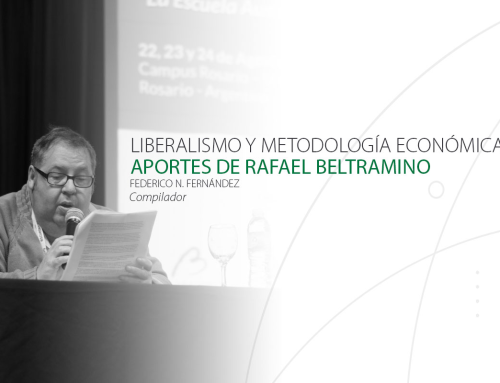Por Samuel Gregg
Fuente: Law & Liberty
21 de marzo 2023
Sometimes the most unexpected of questions and the least certain of answers start people down paths that they never anticipated taking.
That is precisely what happened to Terrence Keeley, who, until June 2022, was a managing director, global head, and senior adviser at Blackrock, Inc., the world’s largest asset manager. His responsibilities included managing Blackrock’s relationships with institutions ranging from central banks to finance ministries. That’s about as much of an insider as one can be in the asset management world.
At an investment conference in 2021, Keeley asked a climate change specialist a routine question about just how warm the world was likely to be in 70 years’ time. The answer that he received was a mixture of honest uncertainty and predictions ranging from much hotter to not-as-bad-as-imagined. It also, however, generated considerable consternation among the audience. They suddenly realized that their efforts to leverage their investments in ways they thought would help combat climate change might all be for naught. For Keeley, the exchange started a process of asking questions about how investors should think about such matters. This took him in very unexpected directions.
Part of that journey involved growing skepticism on Keeley’s part about something embraced by some of America’s most prominent CEOs: Environment, Social, and Governance (ESG) investing. Broadly speaking, ESG purports to allow people to invest in ways that make a profit while simultaneously protecting the environment; advancing various social causes (gender equality, more wealth equity, fostering trade unions, and other objectives often associated with social justice ideas); and promoting forms of corporate governance that focus on furthering stakeholders’ interests as much if not more than those of shareholders. In many cases, the objectives come straight from the United Nations 2015 Sustainable Development Goals.
The more Keeley looked closely at ESG, the more his doubts grew about the underlying theory and capacity to deliver on its goals. The end result of Keeley’s journey is Sustainable: Moving Beyond ESG to Impact Investing (2022)—an insider’s account of ESG and a detailed critique of its workings.
More than Money
One foundation of Keeley’s book is his conviction that those in finance need to understand themselves as being involved in more than the business of engineering money. For Keeley, it is a field in which all-around human excellence can be realized. He also believes that those working in fields like asset management have, like everyone else, some responsibilities for the general welfare. In Keeley’s case, this is derived from his commitment to the Golden Rule.
Yet, as Keeley recognizes, it is not always immediately evident what we should do when it comes to doing good. In many respects, knowing what we should not do is simpler. The negative commandments inscribed on the Decalogue’s second tablet, for example, identify particular acts (theft, murder, coveting, etc.) as choices that may never be made, regardless of intention and circumstances. Refraining from evil, however, is only the first prerequisite for choosing the good and thereby promoting the flourishing of oneself and others.
Efforts by asset managers to promote values via ESG can promote severe market distortions that eventually explode in their faces and inflict enormous collateral damage on the rest of us.
At the same time, Keeley recognizes that everyone is not immediately responsible for everything. This necessarily leads to the question: how do those involved in business and finance pursue the good in light of the specific responsibilities associated with their profession? For many people, ESG has become one way of responding to that question. Keeley, however, concludes that the flaws with ESG are of such a magnitude that business needs to move beyond it—and the sooner the better.
Keeley starts with the premise that creating wealth is the sine qua non of finance. “If businesses don’t foster economic growth,” he observes, “nothing else will.” That matters, because many other forms of human development become much harder, and in some instances, impossible, without steady economic growth.
Herein lies the basis for Keeley’s careful critique of ESG. Investment firms’ priority must be their shareholders’ long-term economic well-being. It follows, he states, that “Financiers and corporate CEOs are not, nor should they ever be, social or environmentalist justice warriors, forever prioritizing stakeholders at the long-term expense of their shareholders.”
Certainly, firms that largely ignore the political, legal, and cultural contexts in which they operate will soon find themselves unable to circumnavigate entirely foreseeable obstacles to realizing profit. But neither can those involved in the asset management business, Keeley posits, assume the primary responsibilities of other organizations and institutions. Like most other things, there is a necessary division of labor, and finance needs to adopt this logic if it is to realize its specific goals and thereby make wider contributions to humanity’s well-being.
Promise versus Reality
Debates about business’s proper ends and responsibilities are not new. Many in the financial sector have been persuaded that ESG will allow business to continue generating wealth while also playing a positive role in society in ways that go far beyond the world of supply and demand.
The problem, Keeley says, is that ESG simply does not deliver. We have good reason, Keeley states, to be skeptical of ESG’s capacity to realize its professed ends. He points to problems plaguing the entire ESG enterprise from top to bottom. What, for instance, constitutes “sustainability”? Which stakeholders matter more than others? How do we meaningfully compare different ESG funds’ performance, given the varying weights they often assign to different causes? How does one establish an ESG fund’s precise contribution to realizing, say, greater gender equality, given all the other forces seeking to promote the same end? “What algorithms,” he asks, “should [corporations] use to achieve optimality between their growing market share and paying higher wages?”
Keeley goes to the heart of the matter by asking ESG boosters two very direct questions. First, “What verifiable impacts have your investments had so far on the business world, the real world, and your finances—that is to say, impacts that you can directly measure?” The second is “If you continue doing exactly what you are doing now, will humanity’s most dire environmental and social problems be solved?” His objective in posing these questions is to demonstrate to ESG advocates that their answers will likely be unsatisfying.
To make his point, Keeley examines in considerable detail the different ways in which some major companies have sought to inject ESG criteria into their investment strategies. He accompanies this with attention to how many other businesses have tried to promote extra-economic purposes throughout their organizational culture, partly because of the same concerns that drive ESG.
Though very detailed, this part of the book is one of the best accounts that I have read by an insider of how corporate America has grappled with these matters. Keeley combines meticulous attention to fields ranging from economic history to price theory, risk modelling, and empirical studies of the performance of sovereign wealth funds with poignant personal insights. The picture of ESG that emerges is at best mixed, which should give corporate America very considerable pause for reflection.
Over and over again, Keeley dispassionately demonstrates the gap between ESG promise and ESG reality. The word “verifiable” appears multiple times throughout the book to drive home the point that ESG struggles to show that it achieves what it aims to realize. Given, for example, what Keeley describes as “the lack of reliable data about corporate emissions, it is hard to know when or even if this objective will be achieved at scale.”
Keeley believes that business and finance are real callings which, like any vocation, embody significance that goes beyond their immediate objectives.
But Keeley also issues several warnings about ESG that anyone who understands the idea of unintended consequences should take seriously. One concerns how efforts by asset managers to promote values via ESG can promote severe market distortions that eventually explode in their faces and inflict enormous collateral damage on the rest of us. According to Keeley, “We learned in the global financial crisis that officially sanctioned bubbles [such as mortgage securities] portend deeper troubles . . . Good intentions create unsustainable market valuations. When those valuations correct, hell can be unleashed.”
Put another way, when enough people pile substantial assets into, say, ESG vehicles that don’t economically merit investments on such a scale, the result can be a financial conflagration whenever the market signals the yawning gap between good intentions (or, in some cases, blinkered ideological commitment) and economic realities. In tones that should chasten the most enthusiastic ESG investor, Keeley warns: “About one thing there should be no debate: the current ESG investment phenomenon has all the makings of a potentially catastrophic investment bubble.”
Is ESG Unsalvageable?
As a book, Sustainable is perhaps the most comprehensive critique of ESG yet written by an industry insider who has followed its development with some sympathy. Indeed, Keeley agrees with some of the ends that ESG seeks to realize, especially concerning climate issues. He wants to find ways to help business and finance marshal their immense creative powers toward realizing some of the goals that ESG advocates say that they care about.
In part, this reflects Keeley’s belief that business and finance are real callings which, like any vocation, embody significance that goes beyond their immediate objectives. No one, Keeley believes, whatever their occupation, can bury their heads in the sand in the face of widespread social, cultural, and economic problems. That, he states, flows from the logic of embracing the Golden Rule.
As a practical and institutional manifestation of commitment to addressing such issues, Keeley recommends that approximately 1.6 percent of the $220 trillion under management by the world’s biggest investors be focused on impact investing, with a particular focus on climate change. By this, he has in mind investment strategies such as “green and social impact bonds, which generate investment income while verifiably doing good.” The models to which he points are approaches used by particular NGOs that, in Keeley’s view, are hard-headed about the challenges involved.
To the extent that this remained a bottom-up enterprise, Keeley’s proposal would be eminently preferable to top-down approaches whereby governments try to mandate such policies or envelop them in “whole-of-government” approaches via administrative fiat. Nonetheless, there are problems with Keeley’s proposed alternative. Can it, for example, be reconciled with existing corporate law concerning the fiduciary responsibilities of directors and CEOs? Will his vision of impact investing, despite its modest scale, only further muddy the waters about the primary telos of business? Then there are the questions about the propensity for governments to try and capture such efforts and effectively turn them into ideological weapons.
The difficulties with Keeley’s proposed alternative to ESG are real. They don’t, however, diminish the fact that Sustainable is one of the more sober-minded books that raises profound questions about a path taken by much of corporate America in recent years. If Keeley’s book succeeds in forcing long-overdue discussions about these matters on Wall Street and inside America’s C-Suite, that alone will be a significant achievement.





Deja tu comentario